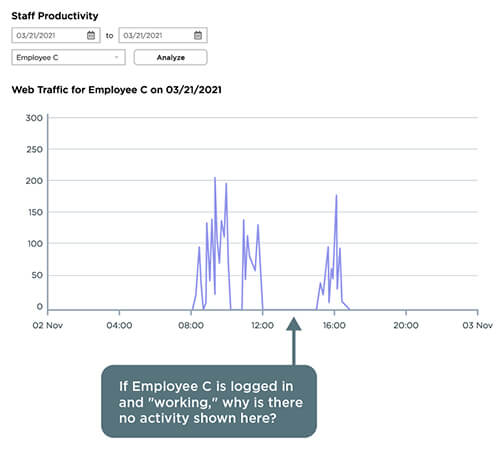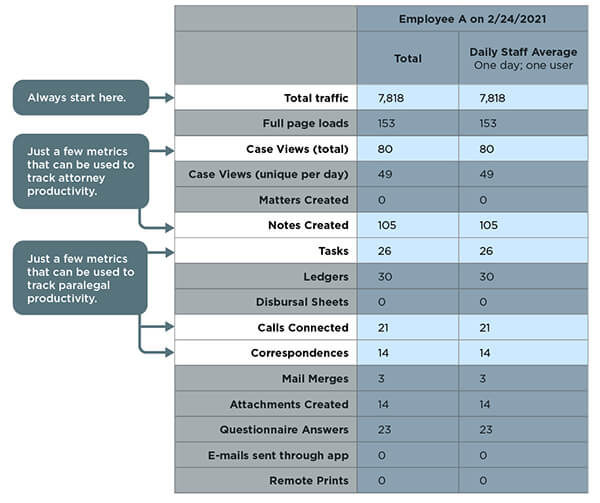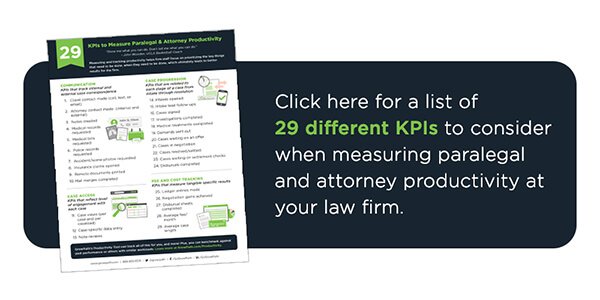Objectively Measuring Productivity – A Formula for Success
Let’s start off by agreeing that measuring the productivity of your attorneys and paralegals is important. And we can also agree on why it’s important: the more productive your legal staff is, the more cases they will efficiently move through the system, and the more satisfied your clients will be, and the more profits your firm will make. Sounds easy, right?
But there are many different ways to measure employee productivity. In this article, I’d like to offer up straightforward proposition – and a formula to achieve it. When you measure your employees’ work efforts objectively, and communicate this info correctly, you will improve the productivity of your employees and profitability of your firm. So here’s your formula:
Objectivity + Staff Buy-In + Transparency = Increased Productivity & Profits
Now let me break it down for you. As the Vice President of Operations at one of the largest personal injury firms in the Southeast, I practice what I preach. And this formula works.

Objectivity
Being objective means using data – cold hard numbers – to measure performance. Not general impressions, or assumptions, but predefined metrics that are automatically and consistently tracked.
Firm management is asking a lot of their staff these days – lawyers and paralegals are expected to be collaborative and maintain the same level of client contact and service while having to respond to significant changes in their work environment. As management expectations increase and employees strive to meet these expectations, the need for recognition and fairness also increases – and this can be done using objective productivity metrics.
Here’s a list of key performance indicators (KPIs) that you can choose from to objectively measure and track the performance of the attorneys and paralegals at your law firm. The specific KPIs you choose to track will depend on your case management software, its tracking capabilities, and your firm’s defined processes and procedures.
Use the metrics from your case management system as a jumping off place to identify high or low performers and to detect patterns that could impact overall productivity. Then dig deeper to determine the cause of any issues identified. Do you have a good performer who is overwhelmed or a poor performer? Is this a systematic problem that the firm needs to address or an individual productivity issue?
At my firm, our GrowPath case management system has a productivity tool that helps me identify what’s being done, by whom, and when. The first thing I do when checking any employee’s productivity is to look at total traffic, which includes total requests from a user to the server (clicking on a case, completing a reminder, etc.). And then I pull up a timeline of that total traffic which shows me breaks in activity in the day which I can compare to timecards to identify any discrepancies. When I see that there is no activity on the timeline even though the employee is logged in and “working,” I know it’s time to start asking some tough questions.

There are many metrics I track to get a handle on how productive my attorneys are. For example, I often look at “case views” to see how many different client cases they are interacting with during a specific time interval. Or I track “notes created” to gauge the level of activity (case review notes, staff direction, call summaries) of each attorney. These are just a few of the many metrics that GrowPath tracks to help me keep tabs on what they are doing each day. To measure paralegal productivity, I look at “correspondences,” “tasks,” “calls connected,” and several other metrics. The point is…my case management system gives me objective data that I can use to measure productivity.
Staff Buy-in
When employees feel that a performance management system is objective and fair, they also think it’s effective. And that means it can be used to motivate work performance and improve productivity. I’ve covered objectivity above and will discuss fairness here. Because fairness is needed for staff buy-in.
To demonstrate that your measurement of attorney and paralegal productivity is fair, follow these three guidelines:
- Be thoughtful about how you communicate. When describing how your case management software will track productivity metrics, describe your system as a fairness tool. Emphasize that it takes subjectivity out of the picture and allows performance to be honestly assessed.

- Emphasize that employee KPIs are linked to overall firm performance. Show employees how their work fits into the larger picture of what the firm is trying to accomplish to build a strong sense of meaning and purpose.
- Recognize and reward standout performance. Look at the data and use it to highlight your star performers. Encourage these individuals to share tips and work habits that have helped them with the team.
Following these three ground rules will help your attorneys and paralegals feel fairly evaluated, and that, in turn, will help them buy into your productivity measures.
GrowPath’s productivity tool allows my attorneys and paralegals to observe and track their own KPIs. It also allows my managers to compare the KPIs of different employees with similar caseloads or to compare a paralegal’s performance to the team average, which can bring to light new practices and procedures that benefit the entire department. For example, the tool might reveal that a certain paralegal is pushing out 50% more demands on average per week than the team’s average. The department manager can take this as an opportunity to: a) praise the paralegal’s performance; and b) have that paralegal share whatever tips and procedures were used to facilitate the stellar performance.
The tool even has the ability to allow employees to compare their performance to that of their co-workers, but this is a permission–based capability that each team must decide whether or not to enable.
Transparency
Sharing information between managers and employees creates openness and accountability and is the right thing to do. And when employees see things more clearly, employee engagement and performance is boosted.
Transparency leads to certainty.
When your staff can access their own productivity numbers, they feel included in the loop and more in control of their own destinies. People don’t like being kept in the dark. Transparency eliminates the mystery that often accompanies performance evaluations and appraisals. If they know what they are being judged on and can see how they are measuring up, they can react, plan, and perform. If they see that they are underperforming expectations, they can reach out to a supervisor to get assistance or additional training.
When employees feel out of the loop and unaware of how they are being evaluated, less happens – they trust managers and coworkers less, they feel less firm loyalty, and they are less motivated to perform. Conversely, a work environment that transparently employs productivity measures opens the door to much more – more trust in management, a more cohesive team atmosphere, and more objective performance reviews. And more is better in this case – more kick-starts motivation.
Transparency creates a sense of fairness.
When employees understand why decisions are made, why raises are given, or why promotions are granted, a sense of fairness is established. Having access to their own performance stats allows employees to change their behavior. When employees can see these facts for themselves, they feel that things are fair, and this can be deeply rewarding.
Transparency builds accountability and ownership at the individual level.
When attorneys and paralegals can track their own KPIs, they generally become more accountable for their work performance and take ownership for their responsibilities. This permits managers to stop micromanaging, a practice which generally creates resentment and ill will.
Transparency leads to certainty, fairness, and accountability which lead to empowered and engaged firm employees which leads to increased productivity. And when your employees are more productive, your firm is more profitable.
Nothing could be more transparent than our firm’s GrowPath case management software. My employees can view their performance on KPIs that are up-to-date 24/7, and they can track their performance over time and can compare performance to different times. It creates ownership and drives productivity.
In summary, I encourage you to remember and follow this formula as you put the systems and measurements in place to increase your firm’s productivity:
Objectivity + Staff Buy-In + Transparency = Increased Productivity & Profits
